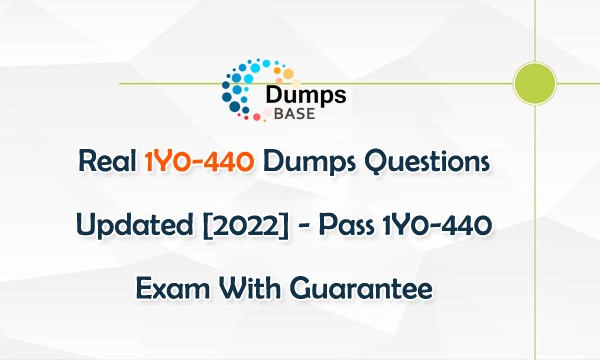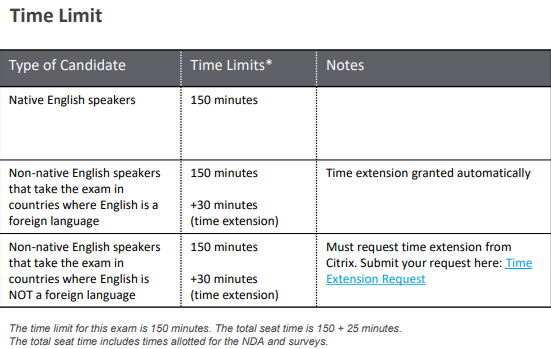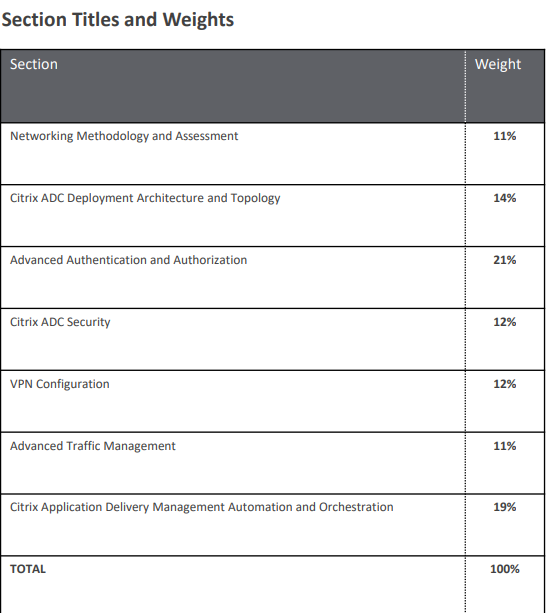Real 1Y0-440 Dumps Questions Updated [2022] - Pass 1Y0-440 Exam With Guarantee
In order to pass 1Y0-440 Architecting a Citrix Networking Solution certification exam, you are highly recommended to choose real Citrix 1Y0-440 dumps questions as the preparation materials. The real and original Citrix 1Y0-440 exam dumps updated recently based on the actual exam objectives ensure that you can pass Architecting a Citrix Networking Solution 1Y0-440 exam successfully. The Citrix 1Y0-440 exam dumps of DumpsBase include the 100% real exam questions and all the answers have been verified by the top experts. The 1Y0-440 dumps questions provided by DumpsBase enable you to comprehend the topics of 1Y0-440 Architecting a Citrix Networking Solution certification exam. DumpsBase guarantees that you can pass 1Y0-440 Architecting a Citrix Networking Solution exam to achieve Citrix Certified Expert - App Delivery and Security (CCE - AppDS) certification successfully.

1Y0-440 Exam Is The Requirement OF Citrix Certified Expert - App Delivery and Security (CCE - AppDS) Certification
When will you take the 1Y0-440 Architecting a Citrix Networking Solution exam? It is the requirement of getting Citrix Certified Expert - App Delivery and Security (CCE - AppDS) certification. Candidates know that Citrix App Delivery and Security certification is the popular certification, which validates the knowledge and skills needed to leverage the full capabilities of Citrix ADC, including implementation for app and desktop delivery, networking performance and optimization, network security, and automation and orchestration.
To earn Citrix App Delivery and Security certification, candidates are required to complete three levels in sequence:
Citrix Certified Associate - App Delivery and Security (CCA - AppDS)
Citrix CCA-AppDS certification is the associate level certification, which validates the knowledge and skills required by network administrators and engineers to implement and manage Citrix ADC for traffic management, load balancing, content switching and SSL offloading or manage enterprise environments consisting of Citrix ADC and Citrix Gateway for secure remote access to desktops, applications and data. There is no prerequisite for earning the Citrix CCA-AppDS certification, and you have three options to earn the Citrix Certified Associate - App Delivery and Security (CCA - AppDS) certification:
Option 1: Pass 1Y0-230 Citrix ADC 12 Essentials and Citrix Gateway. However, the English version of Citrix 1Y0-230 exam has been retired on March 25, 2021. It is only available in Japanese now.
Option 2: Pass 1Y0-241 Deploy and Manage Citrix ADC 13 with Traffic Management exam successfully.
Option 3: Pass 1Y0-231 Deploy and Manage Citrix ADC 13 with Citrix Gateway exam.
Citrix Certified Professional - App Delivery and Security (CCP - AppDS)
Citrix CCP-AppDS certification is the professional level certification, which requires candidates to earn the CCA-AppDS certification as the prerequisite. The Citrix Certified Professional - App Delivery and Security (CCP - AppDS) validates the minimum requisite knowledge and skills required for a Citrix networking professional who can deploy and/or manage Citrix Web App Firewall to secure application access in a Citrix ADC 13 environment, as well as Citrix Application Delivery Management to administer a Citrix ADC environment or optimize Citrix ADC-managed application delivery traffic. The written exam of getting CCP-AppDS certification is 1Y0-341 Citrix ADC Advanced Topics – Security, Management, and Optimization exam.
Citrix Certified Expert - App Delivery and Security (CCE - AppDS)
Candidates who have earned the Citrix CCP-AppDS certification successfully can go on preparing for the Citrix Certified Expert - App Delivery and Security (CCE - AppDS) certification. The expert level certification, Citrix Certified Expert - App Delivery and Security (CCE - AppDS) mainly validates the skills that experienced IT solution designers such as architects, engineers, and consultants need in order to assess and design comprehensive architecture of a Citrix networking environment and configure complex networking configurations. It is required to pass 1Y0-440 Architecting a Citrix Networking Solution exam.
Architecting a Citrix Networking Solution 1Y0-440 Exam Are Available In English
1Y0-440 Architecting a Citrix Networking Solution exam covers advanced Citrix networking configurations and leading Citrix design principles, which mainly focuses on those topics that are most important for IT Professionals with extensive networking and Citrix ADC experience. It certifies that canddiates have the requisite knowledge and skills required for defining the overall structure or architecture of a Citrix networking environment. Real Citrix 1Y0-440 exam contains 64 questions written in English. Successful candidates are required to get 65% score. Additonally, native English speakers and non-native English speakers have different time limites to complete the Citrix CCE-AppDS 1Y0-440 exam.

All Citrix 1Y0-440 exam questions covering the exam sections as listed:

Real 1Y0-440 dumps questions of DumpsBase updated by the top experts, who are good at the 1Y0-440 exam sections. In short the Citrix 1Y0-440 exam dumps questions of DumpsBase are one particular prime source for the preparation of the 1Y0-440 Architecting a Citrix Networking Solution exam.
Read 1Y0-440 Free Dumps Below To Check Real 1Y0-440 Dumps Questions
Real 1Y0-440 dumps questions of DumpsBase are the top-ranked, which guarantee your success in the first attempt. Beside getting verified by the Citrix authorities you could have the 1Y0-440 exam dumps demo prior to buy, making it a lot easier for you to understand the credibility of the most updated Citrix 1Y0-440 dumps questions of DumpsBase.
Which two types of database deployments are supported in Citrix Application Delivery Management? (Choose two.)
A. High Availability
B. Multiple Server
C. Single Server
D. Cluster instance
E. Cloud Services
Answer: A,C
Scenario: A Citrix Architect needs to deploy three VPX instances on NetScaler SDX 11500 device to meet the following design requirements:
Three (3) VPX instances must be provisioned on the SDX device. Instance 1 must be utilized for deploying NetScaler Gateway virtual server. Instance 2 must be utilized for deploying load balancing virtual servers for XML, Director, StoreFront, and Active Directory servers. Separate IP address must be utilized for the communication with XenApp environment and LDAP communication. Instance 3 must be used for deploying the test environment. In the test environment, NetScaler Gateway virtual server, load balancing virtual servers for XML, Director, StoreFront and Active Directory servers must be configured.
How many IP addresses will be required to meet these design requirements?
A. 14
B. 20
C. 16
D. 18
Answer: D
What are three potential risks when examining the disaster recovery plan and implementation for a company? (Choose three)
A. Supporting infrastructure for proposed environment is NOT included in disaster recovery implementation
B. A disaster recovery plan exists but has never been tested
C. A disaster recovery location does NOT exist.
D. Users require mobile devices with continuous access E. Optimal Gateway Routing decisions are NOT understood
Answer: A,B,C
Under which two circumstances will a service be taken out of the slow start phase with automated slow start? (Choose Two)
A. The Service is receiving more than 480 requests per second
B. The new service request rate is slower than the actual request rate
C. The Service does not receive traffic for four successive increment intervals
D. The request rate has been incremented 200 times E. The percentage of traffic that the new service must receive is greater than or equal to 100.
Answer: D,E
Which two methods can a Citrix Architect use to create a Heat Orchestration template? (Choose two)
A. Direct Input
B. Configuration jobs
C. Citrix Web App Firewall Policies
D. File E. Gateway Policies
Answer: A D
Scenario: A Citrix Architect and a team of Workspacelab members met to discuss requirements during the design discussion for a Citrix ADC design project. Specifically, the existing Citrix ADC Configuration must be modified to meet the following authentication conditions:
● Provide users with domain drop-down page
● If the users select workspacelab.com. perform single factor authentication using LDAP
● If the users select AAATM.COM, perform two factor authentication using LDAP and RADIUS
● If the users select NSI-TEST. COM. perform SAML authentication using ADFS
What should the architect use to bind the AAA virtual server to the Citrix Gateway virtual server?
A. 302 based redirect
B. 401 based binding
C. Form based binding
D. Authentication Profile
Answer: D
For which two reasons should a Citrix Architect perform a capabilities assessment when designing and deploying a new Citrix ADC in an existing environment? (Choose two.)
A. Determine operating system and application usage.
B. Identify other planned projects and initiatives that must be integrated with the design and build phase.
C. Determine the new environment networking requirements.
D. Establish and prioritize the key drivers behind a project. E. Assess and identify potential risks for the design and build phase.
Answer: B,E
Which business driver would motivate a Citrix Architect to use the full range of security features on the Citrix ADC to allow for the removal of third party firewalls, proxy devices and multiple URLs?
A. Increase flexibility
B. Improve end user experience
C. Improve performance
D. Enable mobile work styles
E. Consolidate multiple point solutions
Answer: E
A Citrix Architect needs to configure advanced features of NetScaler by using StyleBooks as a resource in the Heat service.
What is the correct sequence of tasks to be completed for configuring NetScaler using the Heat stack?
A. 1. Install NetScaler Bundle for OpenStack2. Deploy the Heat stack3. Register OpenStack with NMAS4. Add NetScaler instances (Optional)5. Prepare the HOT by using the NetScaler heat resources and NetScaler Network Resource6. Create service packages (Add OpenStack tenants)
B. 1. Install NetScaler Bundle for OpenStack2. Register OpenStack with NMAS3. Add NetScaler instances (Optional)4. Create service packages (Add OpenStack tenants)5. Prepare the HOT by using the NetScaler heat resources and NetScaler Network Resource6. Deploy the Heat stack
C. 1. Install NetScaler Bundle for OpenStack2. Add NetScaler instances (Optional)3. Create service packages (Add OpenStack tenants)4. Prepare the HOT by using the NetScaler heat resources and NetScaler Network Resource5. Register OpenStack with NMAS6. Deploy the Heat stack
D. 1. Install NetScaler Bundle for OpenStack2. Prepare the HOT by using the NetScaler heat resources and NetScaler Network Resource3. Register OpenStack with NMAS4. Deploy the Heat stack5. Add NetScaler instances (Optional)6. Create service packages (Add OpenStack tenants)
Answer: D
Scenario: A Citrix Architect has configured a load balancing virtual server for RADIUS authentication. The architect observes that, when the radius authentication action has the virtual server IP address, the authentication falls. However, when any of the individual server IP addresses are used, the authentication works fine.
How should the architect troubleshoot this issue?
A. Change the Logon name attribute in Radius Action
B. Ensure that TCP port 1821 is open from NSIP to backend Radius servers
C. Verify the shared secret on Citrix ADC
D. Change the Radius client from NSIP to SNIP on the Radius server
Answer: D
